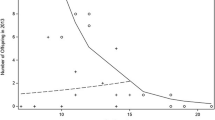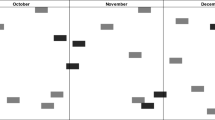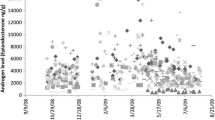Abstract
There is wide interest in the effects of reproductive biology, mating partner preference, and rank on mating success (MS) and reproductive success (RS) in primates. In particular, theory stresses importance on the mechanisms for attaining RS. Most theory hedges on competitive ability and priority of access to resources, whether they be food or estrous females. However, the majority of data used in favor of such hypotheses come from relatively short-term studies. We review these hypotheses based on long-term data from provisioned and unprovisioned populations of Japanese macaques. Neither MS nor RS were consistently attained by high-ranking males and females. For males, female choice and mating partner preference is seen to over-ride most male-male competitive behaviors likely to affect MS and RS through priority of access to estrous females. Long-term mating patterns driven largely by female partner preferences, results in decreasing MS and RS for older higher-ranking males. The long-term trend for females to prefer less familiar or novel partners results in higher MS and RS for younger, middle-ranking males. The effects of this vary according to troop size and the duration of male tenure. For females, no consistent trend was recognized for rank related RS in either provisioned or unprovisioned troops. Non-reproductive mating may provide differential benefit to high-ranking females for access to limited food resources in some habitats but overall the relationship was inconclusive. Distribution and defendability of food resource, rather than provisioning per se may be more important.
Similar content being viewed by others
References
Altmann, S. A. 1962. A field study of the sociobiology of rhesus monkeys (Macaca mulatta).Ann. New York Acad. Sci. 102: 338–435.
Berard, J. 1999. A four-year study of the association between male dominance rank, residency status, and reproductive activity in rhesus macaques (Macaca mulatta).Primates, 40: 159–175.
Berard, J. D.;Nurnberg, P.;Epplen, J. T.;Schmidtke, J. 1994. Alternative reproductive tactics and reproductive success in male rhesus macaques.Behaviour, 129: 177–201.
Bercovitch, F. B. 1992. Re-examining the relationship between rank and reproduction in male primates.Anim. Behav., 44: 1168–1170.
Bercovitch, F. B. 1997. Reproductive strategies of rhesus macaques.Primates, 38: 247–263.
Bercovitch, F. B.;Berard, J. D. 1993. Life history costs and consequences of rapid reproductive maturation in female rhesus macaques.Behav. Ecol. Sociobiol., 32: 103–109.
Carpenter, C. R. 1942. Sexual behaviour of free-ranging rhesus monkeys,Macaca mulatta, 1: Specimens, procedures, and behavioural characteristics of estrus.J. Comp. Psychol., 33: 113–142.
Chapais, B. 1983. Reproductive activity in relation to male dominance at the likelihood of ovulation in rhesus monkeys.Behav. Ecol. Sociobiol., 12: 215–228.
Chapais, B. 1986. Why do adult male and female rhesus monkeys affiliate during the birth season? In:The Cayo Santiago Macaques,Rawlins,R. G.;Kessler,M. J., (eds.), State Univ. New York Press, Albany, pp. 173–200.
Chapais, B.;Mignault, C. 1991. Homosexual incest avoidance among females in captive Japanese macaques.Amer. J. Primatol., 23: 171–183.
Cheney, D. L.;Seyfarth, R. M.;Andelman, S. J.;Lee, P. C. 1988. Reproductive success in vervet monkeys. In:Reproductive Success,Clutton-Brock,T. H. (ed.), Univ. of Chicago Press, Chicago, pp. 384–402.
Cowlishaw, G.;Dunbar, R. I. M. 1991. Dominance rank and mating success in male primates.Anim. Behav., 41: 1045–1056.
Dewsbury, D. A. 1982. Ejaculate cost and mate choice.Amer. Naturalist, 119: 601–610.
Enomoto, T. 1974. The sexual behavior of Japanese monkeys.J. Human Evol., 3: 351–372.
Enomoto, T. 1978. On social preference in sexual behavior of Japanese monkeys (Macaca fuscata).J. Human Evol., 7: 283–293.
Fedigan, L. M. 1983. Dominance and reproductive success in primates.Yrbk. Phys. Anthropol., 26: 91–129.
Fedigan, L. M.;Fedigan, L.;Gouzoules, S.;Gouzoules, H.;Koyama, N. 1986. Lifetime reproductive success in female Japanese macaques.Folia Primatol., 47: 143–157.
Fedigan, L. M.;Gouzoules, H. 1978. The consort relationship in a troop of Japanese monkeys. In:Recent Advances in Primatology,Chivers,D. J.;Herbert,J. (eds), Academic Press, New York, pp. 493–495.
Fredrickson, W. T.;Sackett, G. P. 1984. Kin preference in primates (Macaca nemestrina): relatedness or familiarity?J. Comp. Psychol., 98: 29–34.
Hanby, J. P.;Brown, C. E. 1974. The development of sociosexual behaviours in Japanese macaques,Macaca fuscata.Behaviour, 49: 152–196.
Harcourt, A. H. 1987. Dominance and fertility among female primates.J. Zool. Lond., 213: 471–487.
Hasegawa, T. 1992. Mesu ni totte no rankon, (The evolution of female promiscuity: chimpanzees and Japanese macaques). In:Doubutsu-shakai niokeru Kyodo to Kogeki (Aggression and Cooperation among Animal Societies),Ito,Y. (ed.), Tokaidaigaku-shuppankai, Tokyo, pp. 223–250. (in Japanese)
Hill, D. A. 1991. The patterns of affiliative relationships involving non-natal males in a troop of wild Japanese macaques (Macaca fuscata yakui) in Yakushima In:Primatology Today,Ehara,A.;Kimura,T.;Takenaka,O.;Iwamoto,M. (eds.), Elsevier, Amsterdam, pp. 211–214.
Hrdy, S. B. 1981.The Woman That Never Evolved. Harvard Univ. Press, Cambridge, Massachusetts.
Hrdy, S. B.;Whiten, P. L. 1987. Patterning of sexual activity. In:Primate Societies,Smuts,B. B.;Cheney,D. L.;Seyfarth,R. M.;Wrangham,R. W.;Struhsaker,T. T. (eds.), Univ. Chicago Press, Chicago, pp. 370–384.
Huffman, M. A. 1987. Consort intrusion and female mate choice in Japanese macaquesEthology, 75: 221–234.
Huffman, M. A. 1991a. History of the Arashiyama Japanese macaques in Kyoto, Japan. In:The Monkeys of Arashiyama: Thirty-five Years of Research in Japan and the West,Fedigan,L. M.;Asquith,P. J. (eds.), State Univ. New York Press, Albany, pp. 21–53.
Huffman, M. A. 1991b. Mate selection and partner preferences in female Japanese macaques. In:The Monkeys of Arashiyama: Thirty-five Years of Research in Japan and the West,Fedigan,L. M.;Asquith,P. J. (eds.), State Univ. New York Press, Albany, pp. 101–122.
Huffman, M. A. 1992. Influences of female partner preference on potential reproductive outcome in Japanese macaques.Folia Primatol., 59: 77–88.
Inoue, M. 1995. Application of paternity discrimination by DNA polymorphism to the analysis of the social behavior of primates.Human Evol., 10: 53–62.
Inoue, M.;Mitsunaga, F.;Nozaki, M.;Ohsawa, H.;Takenaka, A.;Sugiyama, Y.;Shimizu, K.;Takenaka, O. 1993. Male dominance rank and reproductive success in an enclosed group of Japanese macaques: with special reference to post-conception mating.Primates, 34: 503–511.
Itani, J. 1972. A preliminary essay on the relationship between social organization and incest avoidance in nonhuman primates. In:Primate Socialization,Poirier,F. E. (ed.), Random House, New York, pp. 165–171.
Itani, J. 1985. The evolution of primate social structures.Man, 20: 593–611.
Itoigawa, N.;Tanaka, T.;Ukai, N.;Fujii, H.;Kurokawa, T.;Koyama, T.;Ando, A.;Watanabe, Y.;Imakawa, S. 1992. Demography and reproductive parameters of a free-ranging group of Japanese macaques (Macaca fuscata) at Katsuyama.Primates, 33: 49–68.
Kawai, M.;Azuma, S.;Yoshiba, K. 1967. Ecological studies of reproduction in Japanese monkeys (Macaca fuscata), I: Problems of the birth season.Primates, 8: 35–74.
Koyama, N.;Takahata, Y.;Huffman, M. A.;Norikoshi, K.;Suzuki, H. 1992. Reproductive parameters of female Japanese macaques thirty years data from the Arashiyama troops, Japan.Priamtes, 33: 33–47.
Kuester, J.;Paul, A.;Arnemann, J. 1994. Kinship, familiarity and mating avoidance in Barbary macaques,Macaca sylvanus.Anim. Behav., 48: 1183–1194.
Manson, J. P. 1992. Measuring female mate choice in Cayo Santiago rhesus macaques.Anim. Behav., 44: 405–416.
Manson, J. P. 1995. Do female rhesus macaques choose novel males?Amer. J. Primatol., 37: 285–296.
McMillan, C. A. 1989. Male age, dominance and mating success among rhesus macaques.Amer. J. Phys. Anthropol., 80: 83–89.
Mitsunaga, F.;Nozaki, M.;Inoue, M.;Takenaka, O.;Sakura, O.;Sugiyama, Y.;Ohsawa, H. 1992. Steroid hormones and sexual behavior of female Japanese monkeys in an enclosed group. In:Topics in Primatology, Vol. 2.Itoigawa, N.;Sugiyama, Y.;Sackett, G. P.;Thompson, R. K. P. (eds.), Univ. of Tokyo Press Tokyo, pp. 23–34.
Moore, J.;Ali, R. 1984. Are dispersal and inbreeding avoidance related?Anim. Behav., 32: 94–112.
Nigi, H.;Hayama, S.;Torii, R. 1990. Copulatory behavior unaccompanied by ovulation in the Japanese monkey (Macaca fuscata).Primates, 31: 243–250.
van Noordwijk, M. A.;van Schaik, C. P. 1999. The effects of dominance rank and group size on female lifetime reproductive success in wild long-tailed macaquesMacaca fascicularis.Primates, 40: 105–130.
Nozaki, M. 1991. Mechanisms controlling seasonal breeding in Japanese monkeys.Primate Res., 7: 103–125. (in Japanese with English abstract)
Oi, T. 1996. Sexual behaviour and mating system of the wild pig-tailed macaque in West Sumatra. In:Evolution and Ecology of Macaque Societies,Fa,J. E.;Lindburg,D. G. (eds.), Cambridge Univ. Press, Cambridge, pp. 342–368.
Okayasu, N. 1989a. Part 1: Prolonged and simultaneous estrus. In: Estrus and female mate choice during troop takeover in a wild Japanese macaque troop on Yakushima Island. Ph.D. diss., Kyoto Univ., Kyoto.
Okayasu, N. 1989b. Part 2: Promiscuous mating and partner preference. In: Estrus and female mate choice during troop takeover in a wild Japanese macaque troop on Yakushima Island. Ph.D. diss., Kyoto Univ., Kyoto.
Packer, C. 1979. Male dominance and reproductive activity inPapio anubis.Anim. behav., 27: 37–45.
Paul, A.;Kuester, J. 1996. Differential reproduction in male and female Barbary macaques. In:Evolution and Ecology of Macaque Societies,Fa,J. E.;Lindburg,D. G. (eds.), Cambridge Univ. Press, Cambridge, pp. 293–317.
Perloe, S. I. 1992. Male mating competition, female choice and dominance in a free ranging group of Japanese macaques.Primates, 33: 289–304.
van Schaik, C. P. 1983. Why are diurnal primates living in groups?Behaviour, 87: 120–144.
van Schaik, C. P.;van Noordwijk, M. A.;de Boer, R. J.;den Tonkelaar, I. 1983. The effect of group size on time budges and social behaviour in wild long-tailed macaques (Macaca fascicularis).Behav. Evol. Sociobiol., 13: 173–181.
Silk, J. A. 1983. Local resource competition and facultative adjustment of sex ratios in relation to competitive abilities.Amer. Naturalist, 121: 56–66.
Small, M. F. 1988. Female primate sexual behavior and conception.Cur. Anthropol., 29: 81–100.
Small, M. F. 1989. Female choice in nonhuman primates.Yrbk. Phys. Anthropol., 32: 103–127.
Smuts, B. B. 1983a. Dynamics of ‘special relationships’ between adult male and female olive baboons. In:Priamte Social RelationshipsHinde, R. A. (ed.), Blackwell, Oxford, pp. 112–116.
Smuts, B. B. 1983b. ‘Special relationships’ between adult male and female olive baboons: selective advantages. In:Primate Social Relationships,Hinde,R. A. (ed.), Blackwell, Oxford, pp. 262–266.
Soltis, J.;Mitsunaga, F.;Shimizu, K.;Nozaki, M.;Yanagihara, Y.;Domingo-Roura, Z.;Takenaka, O. 1997. Sexual selection in Japanese macaques, II: Female mate choice and male-male competition.Anim. Behav., 54: 737–746.
Sprague, D. S. 1989. Male inter-troop movement during the mating season among the Japanese macaques of Yakushima Island, Japan. Ph.D. diss., Yale Univ., New Haven.
Sprague, D. S. 1992. Life history and male inter-troop mobility among Japanese macaques (Macaca fuscata).Int. J. Priamtol., 13: 437–454.
Sprague, D. S. 1998. Age, dominance rank, natal status, and tenure among male macaquesAmer. J. Phys. Anthropol., 105: 511–521.
Stephenson, G. R. 1975. Social structure of mating activity in Japanese macaques. In:Proceedings from the Symposia of the Fifth Congress of the International Primatological Society, Nagoya, Japan, August 1974,Kondo,S.;Kawai,M.;Ehara,A.;Kawamura,S. (eds.), Japan Science Press, Tokyo, pp. 63–115.
Sugiyama, Y.;Ohsawa, H. 1982. Population dynamics of Japanese monkeys with special reference to the effect of artificial feeding.Folia Primatol., 39: 238–263.
Takahata, Y. 1980. The reproductive biology of a free-ranging troop of Japanese monkeys.Primates, 21: 303–329.
Takahata, Y. 1982. The socio-sexual behavior of Japanese monkeys.Z. Tierpsychol., 59: 89–104.
Takahata, Y.;Suzuki, S.;Agetsuma, N.;Okayasu, N.;Sugiura, H.;Takahashi, H.;Yamagiwa, J.;Izawa, K.;Furuichi, T.;Hill, D. A.;Maruhashi, T.;Saito, C.;Sato, S.;Sprague, D. S. 1998a. Reproduction of wild Japanese macaque females of Yakushima and Kinkazan Islands: a preliminary report.Primates, 39: 339–349.
Takahata, Y.;Suzuki, S.;Okayasu, N.;Sugiura, H.;Takahashi, H.;Yamagiwa, J.;Izawa, K.;Agetsuma, N.;Hill, D. A.;Saito, C.;Sato, S.;Tanaka, T.;Sprague, D. S. 1998b. Does troop size of wild Japanese macaques influece birth rate and infant mortality in the absence of predators?Primates, 39: 245–251.
Tokuda, K. 1961–62. A study on the sexual behavior in the Japanese monkey troop.Primates, 3(2): 1–40.
Trivers, R. L.;Willard, D. E. 1973. Natural selection of parental ability to vary the sex ratio of offspring.Science, 179: 90–92.
Watanabe, K.;Mori, A.;Kawai, M. 1992. Characteristic features of the reproduction of Koshima monkeys,Macaca fuscata fuscata: a summary of 34 years of observation.Primates, 33: 1–32.
Westermarck, E. 1889.The History of Human Marriage. Allerton Press, New York.
Wolf, W. P. 1995.Sexual Attraction and Childhood Association: A Chinese Brief forEdward Westermarck. Stanford Univ. Press, Stanford.
Wolfe, L. D. 1984. Female rank and reproductive success among Arashiyama B Japanese macaques (Macaca fuscata).Int. J. Primatol., 5: 133–143.
Wolfe, L. D. 1986. Sexual strategies of female Japanese macaques (Macaca fuscata).Human Evol., 1: 267–275
Wrangham, R. W. 1980. An ecological model of female-bonded primate groups.Behaviour, 75: 262–300.
Zuckerman, S. 1932.The Social Life of Monkeys and Apes. Kegan Paul, London.
Author information
Authors and Affiliations
About this article
Cite this article
Takahata, Y., Huffman, M.A., Suzuki, S. et al. Why dominants do not consistently attain high mating and reproductive success: A review of longitudinal Japanese macaque studies. Primates 40, 143–158 (1999). https://doi.org/10.1007/BF02557707
Received:
Accepted:
Issue Date:
DOI: https://doi.org/10.1007/BF02557707




